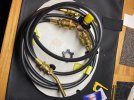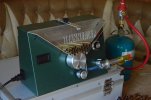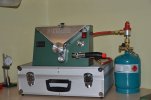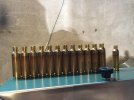The Annealeez is a great unit at at a very good price. Mine is 5 yrs old and works great!I'd say the amp machine is probably the best . once you get things figured out it will anneal exactly the same every time , but expensive .
I think most of the flame type annealers do a good job . there are a couple different ideas with them . some use one torch and spin the case , others use two or three torches and the case is stationary . I use a two torch ballistic edge machine . it seems to do a good job . I keep some old brass to set up on , so I don't cook my new brass . I've never heard anything bad about any of them really . a couple of names that come to mind are ; bench source , annealeez . if you are handy with building projects you might want to consider a skips machine . there's others , these are the couple I can think of right off .

skips annealer - Bing
Intelligent search from Bing makes it easier to quickly find what you’re looking for and rewards you.www.bing.com
Annealeez – For a Hot Piece of Brass!
annealeez.com
I can't find a link to the ballistic edge , they must be out of production ??
You are using an out of date browser. It may not display this or other websites correctly.
You should upgrade or use an alternative browser.
You should upgrade or use an alternative browser.
brass annealing machine
- Thread starter Baboltin
- Start date
 Help Support Long Range Hunting Forum
Help Support Long Range Hunting Forum
I don't quite agree. It sure stop the neck splitting. The primer pocket wore out next. But I double the life of my cases or better. That's from pushing them hard.Does most everyone agree that they seen little to no improvement or worth of annealing there brass ?
Rick LeMonnier
Member
Annealing made perfect (AMP) is the unit I bought and it's easy to operate and have done 40,000+ pcs of brass. Works perfectly and doesn't have an open flame like some other units. You can automate as well. This is great equipment.I am in the market for a annealing machine but they aren't cheap I made a post for a used one in the classified section. A couple quick question.
what ones are good ones that you would recommend?
what ones should I stay away from?
what are the issues with the good and bad ones? And does anyone have one they want to part with?
Jim74
Member
Any flame annealer your going to need to adjust. I was going to purchase a Bench Source as in my review, it was the best propane annealer period. I actually purchases hoses, torches and a splitter to use a 20 gal propane tank to ensure I did not have an issue with low flame as the small tanks emptied. I just could not bring myself to using propane in my home. So I saved and as others have done, bought an AMP. You may also want to look at an Annie induction annealer. The cost is in the high $400's to about $550 with options available. This would be worth reviewing. I spent many hours reviewing videos on annealers, the Bench Source was far and above any of the other propane annealers in my opinion. My suggestion would be to invest your time before you invest your money. I know $1400 is crazy money for the hobby we love, but as I love accuracy and perfection without burning my house down, it made sense to me. I hate buying only to upgrade later spending more money. Best of luck with your decision.That's good to know, That it is a pain to adjust it maybe I won't consider the bench source.
Attachments
Blkrflguy
Well-Known Member
Not sure what to make of that.. I've had as much as 80-90 cases in the hopper and never had an issue with the wheels. The last case came off just like the first.Annealeze has one problem that is making me look at a different machine. The problem is the wheels are made if some type of plastic maybe delrin. When the hot annealed case drops into the slot in the lower wheel the delrin starts to melt and after about 30 cases the delrin will start to make the case stick in the lower wheel and also leave some plastic residue on the case that has to be manually removed. Its a pain in the XXX. The wheels should be made of metal. I am looking at the machine on mikesreloadingbench.
Citified
Well-Known Member
Like many of the posters here, I reloaded for decades without annealing cases. The scrap rate on cases was not a factor when components were more readily available.
A few years ago I started annealing my cases with Annealez. The unit is simple, durable and does not have a steep
learning curve. I looked at several brands including Amp before acquiring the unit.
I reload in many calibers so I opted for the adapter that handles different size cases.
This unit works extraordinarily well and extends case life significantly.
I didn't see a noticeable difference in accuracy but consistency is certainly evident. With good brass being hard to find and costly, it just makes sense to anneal in my opinion. If cost is no object, but the Amp unit.
A few years ago I started annealing my cases with Annealez. The unit is simple, durable and does not have a steep
learning curve. I looked at several brands including Amp before acquiring the unit.
I reload in many calibers so I opted for the adapter that handles different size cases.
This unit works extraordinarily well and extends case life significantly.
I didn't see a noticeable difference in accuracy but consistency is certainly evident. With good brass being hard to find and costly, it just makes sense to anneal in my opinion. If cost is no object, but the Amp unit.
This is long and full of tech that is likely boring to many so you may just want to skim or skip it.
I have gleaned any knowledge I have from annealing case necks using various heat sources and then spending hours searching for and reading thru studies and papers trying to glean nuggets of pertinent info and making deductions based off it and observations. AMP early on added a nice amount of case neck specific technical data on what there final state goal is. What I am not is someone with any professional or academic institutional study of metallurgy. Below I'm only going to reference a couple sources but to really explore and get a better picture it took me going thru numerous papers. Most time was reading thru papers that gave me nothing useful.
I think, since annealing has become significantly more wide spread, as the value both for performance consistency and case longevity is recognized; it would be helpful to break down the technical details to understand exactly what the ideal state is. How various forces effect the properties and structure of the case neck. I still have numerous questions. Some I think I know the basic reasons others still searching and learning.
As an couple examples:
Consider the repeated observation, that a case neck sized and seated with a bullet in a short period, hours, uses significantly less force to seat the bullet, than does one after a longer period of time, weeks to months. This shows that the brass structure and retained energy is not static after significant plastic deformation via mechanic force (resizing die) is applied to them.
Necks heated below the temp / time window, generally recognized as needed to affect structural change, seem to display properties indicative of some stress relief yet no discernable change in hardness. This has been observed with molten salt bath @ 900-1000F for period of a few (3-10 sec), too short to bring the submerged neck to temperature equilibrium with the salt solution and not affect hardness/temper. (According to research by University of Illinios, a fully submerged piece in that 450-500°C of molten lead takes 19 second just to reach temp. In neck only annealing, with the significant amount of case mass not submerged and acting as a very effective heat sink then time would have to be significantly increased.) I think the start of the recovery phase maybe more gradual and start sooner. It may also have mini sub stages. My SWAG.
Ref:
Grain Sizes Produced by Recrystallization and Coalescence in Cold-Rolled Cartridge Brass (graph on page 25 Fig. 3. Heating Rate in Molten Bath)
Our goal is to achieve a temper and more precisely, a differential temper of a certain hardness and ductility taper. Most research that people quote, regurgitate, or frankly that is done, seems to have no correlations to time/temperatures combo we use in neck annealing as it's focused on the recrystallization phase or returning to that of the inItally pre-rolled state or further to crystal grain regrow. It requires digging thru many of these studies and finding that odd few nuggets to really be able to gain the knowledge to answer those questions.
Brass Stages of Annealing:
(1) Recover
(2) Recrystallization
(3) Coalescence
Everything we care about and the annealing stage we are keeping our case necks in is that 1st stage; Recovery. It is also the shortest of the stages in terms of time especially at high temperatures that we need to use to overcome the extremely efficient heat conductivity of brass and not effect the rest of the case.
You will see even in research dealing with actual case production statements about recylstallization happening at any temp above 750°F/400°C. The issue is that is meant in the context of a certain time window for entire object annealing which is a minimum of 30 minutes window. It has nothing to do with the goals of neck annealing to a differential temper or those of case manf when they do final neck annealing stages. This appearance of dichotomy can be seen clearly in this master thesis from 2018 done at the Norma case manufacturing facility:
Ref:
Variations in Hardness and Microstructure in Cartridge Cases at Annealing By
Richard Ohlsson
"Earlier reports by Hajizadeh et.al [6] have found that for brass annealed at 400°C, the brass has passed the recovery stage and entered the recrystallization stage."
The supporting graphs are on page 5 of the paper.
You will notice while the graph fig 3 has no reference to time and is labeled recrystallization graph fig 4 labeled for hardness denotes the time duration of 30 minutes. Makes it very murky for those looking for the infon without metallugic knowledge.
As we reach the sections on case neck annealing stages we start to see much more familiar annealing times we are accustom to, as shooters, in neck annealing.
Under Figure 10 on page 12 we find this statement that helps clear things up in terms of case necks:
"As seen in Table 2, the cases experience two different annealing's of the neck during the manufacturing processes. The annealing at Norma is made by induction heating where the Win Mag at the first neck annealing is annealed for 14 seconds at an induction of 2.8 kW and at the second neck annealing ca 14-15 sec at 6.1 kW. The exact temperatures have not been measured but previous measurements at other cases at Norma Precision AB has shown that the temperatures lie in the range of 350-600°C. From Figure 5, it is seen that annealing at those temperatures does not change the phase of the microstructure for the brass."
I would not get hung up on the power kw output mentioned as its effect can vary greatly based on the coil shape dimensions etc. Instead notice the temperatures and time mentioned. Also understand they are dealing with cases that have the maximum tolerated deformation changes while keep case loss low.. Most of the shoulder and upper case body can handle some annealing as well. But as can be seen final neck annealing us done @ 600°C/1112°F for 14-15 sec. It should also be mentioned the heat produced thru induction freq is penetrative in the thin case necks compared to that of heat via flame or liquid submersion. If the actual full power of those machines were used you could forge weld steel. My point is these numbers do not directly convert to other induction machines and certainly not other heat sources for annealing. Induction of these machines heats the necks to temp in under 1 sec. Complete Submersion 19 seconds, neck only submersion with case as heatsink 30 sec??, propane flame 1800°F+ 2-4 sec
Finally, if we proceed to page 19 figure 7 we can see how the case necks after final annealing have a deferential temper or progressive hardness as you move away from the case mouth further into the neck. Average: 1mm: 105 hv, 3mm: 108 hv, 6mm: 115 hv
What is the ideal state of the temper for most consistent bullet release force or case neck expansion / ductility balanced with minimal strength to prevent neck deformation during sizing?
We always speak of neck tension in terms of a dimension under the bullet bearing surface diameter, friction fit. But this is a unique individual/specific unit measure. What our real goal is bullet release consistency for the entire mated surface area of bullet to case neck and also cartridge neck unit to unit for a given inside diameter.
From everything I have learned the future of home case neck annealing is in induction systems. Not that torch based can not and do not work, they do andvhave for a very long time. But induction allows a much greater level of precision and far simpler setup and increased safety as there is no open flame or pot of molten solution waiting to start a fire or explode, respectively. No need for case rotation is another.
With little knowledge you can put a basic induction annealer together for around a couple hundred. If you are somewhat skilled you can add varying amounts of automation. Its the future; thats my personal opinion.
I have gleaned any knowledge I have from annealing case necks using various heat sources and then spending hours searching for and reading thru studies and papers trying to glean nuggets of pertinent info and making deductions based off it and observations. AMP early on added a nice amount of case neck specific technical data on what there final state goal is. What I am not is someone with any professional or academic institutional study of metallurgy. Below I'm only going to reference a couple sources but to really explore and get a better picture it took me going thru numerous papers. Most time was reading thru papers that gave me nothing useful.
I think, since annealing has become significantly more wide spread, as the value both for performance consistency and case longevity is recognized; it would be helpful to break down the technical details to understand exactly what the ideal state is. How various forces effect the properties and structure of the case neck. I still have numerous questions. Some I think I know the basic reasons others still searching and learning.
As an couple examples:
Consider the repeated observation, that a case neck sized and seated with a bullet in a short period, hours, uses significantly less force to seat the bullet, than does one after a longer period of time, weeks to months. This shows that the brass structure and retained energy is not static after significant plastic deformation via mechanic force (resizing die) is applied to them.
Necks heated below the temp / time window, generally recognized as needed to affect structural change, seem to display properties indicative of some stress relief yet no discernable change in hardness. This has been observed with molten salt bath @ 900-1000F for period of a few (3-10 sec), too short to bring the submerged neck to temperature equilibrium with the salt solution and not affect hardness/temper. (According to research by University of Illinios, a fully submerged piece in that 450-500°C of molten lead takes 19 second just to reach temp. In neck only annealing, with the significant amount of case mass not submerged and acting as a very effective heat sink then time would have to be significantly increased.) I think the start of the recovery phase maybe more gradual and start sooner. It may also have mini sub stages. My SWAG.
Ref:
Grain Sizes Produced by Recrystallization and Coalescence in Cold-Rolled Cartridge Brass (graph on page 25 Fig. 3. Heating Rate in Molten Bath)
Our goal is to achieve a temper and more precisely, a differential temper of a certain hardness and ductility taper. Most research that people quote, regurgitate, or frankly that is done, seems to have no correlations to time/temperatures combo we use in neck annealing as it's focused on the recrystallization phase or returning to that of the inItally pre-rolled state or further to crystal grain regrow. It requires digging thru many of these studies and finding that odd few nuggets to really be able to gain the knowledge to answer those questions.
Brass Stages of Annealing:
(1) Recover
(2) Recrystallization
(3) Coalescence
Everything we care about and the annealing stage we are keeping our case necks in is that 1st stage; Recovery. It is also the shortest of the stages in terms of time especially at high temperatures that we need to use to overcome the extremely efficient heat conductivity of brass and not effect the rest of the case.
You will see even in research dealing with actual case production statements about recylstallization happening at any temp above 750°F/400°C. The issue is that is meant in the context of a certain time window for entire object annealing which is a minimum of 30 minutes window. It has nothing to do with the goals of neck annealing to a differential temper or those of case manf when they do final neck annealing stages. This appearance of dichotomy can be seen clearly in this master thesis from 2018 done at the Norma case manufacturing facility:
Ref:
Variations in Hardness and Microstructure in Cartridge Cases at Annealing By
Richard Ohlsson
"Earlier reports by Hajizadeh et.al [6] have found that for brass annealed at 400°C, the brass has passed the recovery stage and entered the recrystallization stage."
The supporting graphs are on page 5 of the paper.
You will notice while the graph fig 3 has no reference to time and is labeled recrystallization graph fig 4 labeled for hardness denotes the time duration of 30 minutes. Makes it very murky for those looking for the infon without metallugic knowledge.
As we reach the sections on case neck annealing stages we start to see much more familiar annealing times we are accustom to, as shooters, in neck annealing.
Under Figure 10 on page 12 we find this statement that helps clear things up in terms of case necks:
"As seen in Table 2, the cases experience two different annealing's of the neck during the manufacturing processes. The annealing at Norma is made by induction heating where the Win Mag at the first neck annealing is annealed for 14 seconds at an induction of 2.8 kW and at the second neck annealing ca 14-15 sec at 6.1 kW. The exact temperatures have not been measured but previous measurements at other cases at Norma Precision AB has shown that the temperatures lie in the range of 350-600°C. From Figure 5, it is seen that annealing at those temperatures does not change the phase of the microstructure for the brass."
I would not get hung up on the power kw output mentioned as its effect can vary greatly based on the coil shape dimensions etc. Instead notice the temperatures and time mentioned. Also understand they are dealing with cases that have the maximum tolerated deformation changes while keep case loss low.. Most of the shoulder and upper case body can handle some annealing as well. But as can be seen final neck annealing us done @ 600°C/1112°F for 14-15 sec. It should also be mentioned the heat produced thru induction freq is penetrative in the thin case necks compared to that of heat via flame or liquid submersion. If the actual full power of those machines were used you could forge weld steel. My point is these numbers do not directly convert to other induction machines and certainly not other heat sources for annealing. Induction of these machines heats the necks to temp in under 1 sec. Complete Submersion 19 seconds, neck only submersion with case as heatsink 30 sec??, propane flame 1800°F+ 2-4 sec
Finally, if we proceed to page 19 figure 7 we can see how the case necks after final annealing have a deferential temper or progressive hardness as you move away from the case mouth further into the neck. Average: 1mm: 105 hv, 3mm: 108 hv, 6mm: 115 hv
What is the ideal state of the temper for most consistent bullet release force or case neck expansion / ductility balanced with minimal strength to prevent neck deformation during sizing?
We always speak of neck tension in terms of a dimension under the bullet bearing surface diameter, friction fit. But this is a unique individual/specific unit measure. What our real goal is bullet release consistency for the entire mated surface area of bullet to case neck and also cartridge neck unit to unit for a given inside diameter.
From everything I have learned the future of home case neck annealing is in induction systems. Not that torch based can not and do not work, they do andvhave for a very long time. But induction allows a much greater level of precision and far simpler setup and increased safety as there is no open flame or pot of molten solution waiting to start a fire or explode, respectively. No need for case rotation is another.
With little knowledge you can put a basic induction annealer together for around a couple hundred. If you are somewhat skilled you can add varying amounts of automation. Its the future; thats my personal opinion.
DJD
Member
- Joined
- May 26, 2017
- Messages
- 10
I am in the market for a annealing machine but they aren't cheap I made a post for a used one in the classified section. A couple quick question.
what ones are good ones that you would recommend?
what ones should I stay away from?
what are the issues with the good and bad ones? And does anyone have one they want to part with?
I have a Benchsource I would entertain selling. Only used 2 or 3 times, my wife bought me the AMP.I am in the market for a annealing machine but they aren't cheap I made a post for a used one in the classified section. A couple quick question.
what ones are good ones that you would recommend?
what ones should I stay away from?
what are the issues with the good and bad ones? And does anyone have one they want to part with?
I use this machine.
Z-Annealer gen-2
I make them.

 reibert.info
reibert.info

 reibert.info
reibert.info
Z-Annealer gen-2
I make them.
Продам установку для отжига Z-Annealer G en-2
Предложу установку для отжига гильз собственного производства второй генерации. Возможность отжига гильз калибра .222 REM - .338 LM включительно....
Z-Meter измерительное и другое оборудование для релоада и высокоточной стрельбы
Z-METER GANVERA - universal reloading measuring multi tool Лучший в мире прибор для проведения измерений в стрелковом деле. Включает в себя полный...
Attachments
Stevenstl86
Well-Known Member
Pm me please.I have a Benchsource I would entertain selling. Only used 2 or 3 times, my wife bought me the AMP.
Do they offer that with a second propane torch head from the other side? That Is a very nice laid out machine from the look of it. How's hunting in the Ukraine? Access to firearms scopes reloading?I use this machine.
Z-Annealer gen-2
I make them.

Продам установку для отжига Z-Annealer G en-2
Предложу установку для отжига гильз собственного производства второй генерации. Возможность отжига гильз калибра .222 REM - .338 LM включительно....reibert.info

Z-Meter измерительное и другое оборудование для релоада и высокоточной стрельбы
Z-METER GANVERA - universal reloading measuring multi tool Лучший в мире прибор для проведения измерений в стрелковом деле. Включает в себя полный...reibert.info
Pm me I'm interested pleaseI have a Benchsource I would entertain selling. Only used 2 or 3 times, my wife bought me the AMP.
Blackhawk
Well-Known Member
I myself have used and am still am using the Annealeeze #2 with digital controller. This allows me to set my dwell and timing for each caliber that I wish to anneal for.I am in the market for a annealing machine but they aren't cheap I made a post for a used one in the classified section. A couple quick question.
what ones are good ones that you would recommend?
what ones should I stay away from?
what are the issues with the good and bad ones? And does anyone have one they want to part with?
It has several features that make it my favorite.
1) Made In America.
2) Built like a tank with a very solid steel frame.
3) Easily set up and easy to change rollers for different size brass .(Additional rollers must be purchased separately)
4) Runs on propane which can be purchased anywhere.
5) Reliable and consistent results providing you do your part.
6) It has one of the best prices on the market for an annealer.
Just my opinion is all.
I know that there are more sophisticated units on the market ,however for the money it just can't be beat!
Additionally Jeff Buck (The Owner) is a very personable and easy going guy.
Each time you fire your rifle the brass especially the case necks and shoulder areas do get stretched to your rifles particular chamber dimensions.
This is known as work hardening . In order to release brass and bring it close to it's original hardness it must be annealed.
If you are concerned about extended case life you in turn must anneal your brass.
True enough after so many firings dependent on whether or not you are using ranged brass which at best has only been fired once, or perhaps it has been discarded after being shot out , or of foreign unquestionable manufacture, or using your own brass
Last edited:



